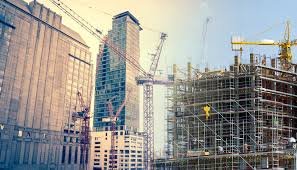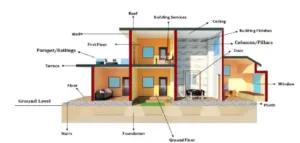HOW TO BUILD A GODOWN IN KATIHAR…
Building a godown in Katihar (a town in Bihar, India) requires additional considerations specific to the region, such as climate, local building regulations, and available materials. Here’s a tailored guide for constructing a godown in Katihar:
1. Location and Land Selection
- Proximity to transport hubs: Katihar is a railway hub, so choosing a site close to Katihar Junction Railway Station or nearby highways (like NH 31) will facilitate easy transportation of goods.
- Land availability: Look for plots in industrial zones or areas zoned for commercial use. You might need to consult with the local Katihar Municipal Corporation or land revenue office for land use restrictions.
- Flood-prone areas: Katihar experiences monsoons and occasional flooding, so select elevated land to avoid waterlogging.
2. Complying with Local Regulations
- Building permits: Apply for the necessary permits from the Katihar Municipal Corporation. This will involve submitting building plans, getting environmental clearances, and adhering to local zoning laws.
- Safety standards: Make sure your godown follows safety norms such as those specified in The National Building Code of India and local guidelines for fire safety, load-bearing capacity, and worker safety.
3. Planning and Design
- Monsoon-resilient design: Since Katihar receives heavy rainfall, design the godown with a sloped roof and efficient drainage system to prevent water accumulation.
- Ventilation: The region can get hot in the summer, so proper ventilation is crucial. Install large windows or vents to allow airflow and reduce internal temperature. Consider industrial fans or other cooling systems.
- Natural lighting: Install skylights or translucent roofing panels to make use of natural light, reducing energy costs.
- Foundation: Given that the soil type in Katihar is primarily alluvial (soft), you might need to reinforce the foundation with deeper footings or piles, depending on soil conditions.
4. Construction Materials
- Locally sourced materials: Utilize locally available materials such as bricks, concrete, and steel to save on transportation costs. You can source construction materials from suppliers in nearby towns like Purnia or Bhagalpur.
- Steel framing: Steel is ideal for large godown structures due to its strength and durability, which can withstand monsoon winds and heavy rainfall.
- Waterproofing: Apply waterproofing membranes to both the roof and the foundation to protect from water seepage during the rainy season.
5. Waterproofing and Drainage System
- Rainwater harvesting: Incorporate a rainwater harvesting system to collect rainwater during the monsoon season. This water can be used for cleaning, irrigation, or cooling purposes.
- Proper drainage: Design the drainage system to handle heavy monsoonal downpours. Install gutters and downpipes that direct water away from the building and into soak pits or drainage channels.
6. Storage Systems and Layout
- Racking: Depending on what you plan to store (grains, perishable goods, etc.), install the appropriate racking system. Use pallet racks for large volumes and shelving for smaller goods.
- Temperature-sensitive storage: If you plan to store temperature-sensitive items (like grains, fruits, or vegetables), consider a cold storage area with proper insulation and cooling systems.
- Loading docks: Create dedicated loading/unloading areas near the entrance, keeping in mind the movement of vehicles and the flow of goods in and out of the warehouse.
7. Security and Safety
- Fire safety: Install fire safety equipment, such as extinguishers, fire alarms, and sprinkler systems, in accordance with local laws. You can consult the Katihar Fire Department for specific requirements.
- Security systems: Given the possibility of theft or vandalism, install CCTV cameras, alarms, and security personnel at key points in the godown.
8. Utilities Setup
- Electricity: Coordinate with the North Bihar Power Distribution Company Limited (NBPDCL) for electricity connections. Ensure sufficient capacity for lighting, fans, and machinery.
- Water supply: Secure a reliable water connection for cleaning, fire safety, and other uses. If needed, set up a borewell on-site.
- Backup power: Power outages are not uncommon in rural Bihar, so invest in a generator or UPS system to ensure continuous operation.
9. Monsoon and Heat-Proofing
- Roof insulation: Install insulation to reduce heat buildup during the summer. Metal roofs can get very hot, so adding a heat-reflective coating can help.
- Pest control: Regular pest control is necessary, especially if you are storing agricultural products like grains. Ensure that your design includes pest-resistant storage methods, such as sealed containers and regular fumigation.
10. Logistics & Transportation
- Road connectivity: If possible, plan for direct access to a major road or highway. Ensure that there’s enough space for trucks to maneuver easily.
- Parking area: Allocate sufficient space for trucks, cargo loaders, and employee parking.
11. Hiring Contractors & Project Management
- Local contractors: Hire local contractors familiar with the region’s building materials and practices. Ensure that they follow all safety and quality standards.
- Timeline: Set realistic construction timelines considering monsoons and material availability. Coordinate with suppliers to avoid delays.
12. Cost Estimation and Budgeting
- Cost of land: Land costs in Katihar vary depending on proximity to commercial centers. Research current rates through real estate agents or local listings.
- Construction costs: Based on the size and complexity of the godown, costs can vary widely. Plan for expenses such as materials, labor, equipment, and utility connections.
- Contingency fund: Set aside a contingency budget (10-15% of total costs) for unforeseen expenses, like delays or price hikes in materials.
13. Final Inspections and Approvals
- Once construction is complete, schedule inspections from local authorities to ensure the godown meets all building and safety regulations.
- Obtain all necessary completion certificates, which may be required to begin operations.
Conclusion
To build a godown in Katihar, it’s essential to adapt to the local climate, select appropriate materials, and adhere to local regulations. With good planning, proper design, and compliance with legal requirements, you can successfully construct a functional and efficient godown that meets your storage needs in the region.











Add comment